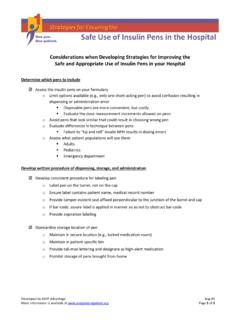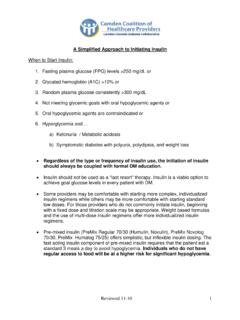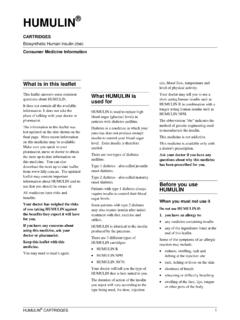Transcription of DEPARTMENT OF HEALTH AND HUMAN SERVICES Medication ...
1 DEPARTMENT OF HEALTH AND HUMAN SERVICES CENTERS FOR MEDICARE & MEDICAID SERVICES Medication administration observation Medication administration observation : Make random Medication observations of several staff over different shifts and units, multiple routes of administration -- oral, enteral, intravenous (IV), intramuscular (IM), subcutaneous (SQ), topical, ophthalmic, and a minimum (not maximum) of 25 Medication opportunities. Do NOT preselect residents for observation . Observe and document all of the resident s medications for each observed Medication administration (this does not mean all of the medications for that resident on different shifts or times). Additionally, if possible, observe medications for a sampled resident whose Medication regimen is being reviewed.
2 Otherwise, observe medications for any resident to whom the nurse is ready to administer medications. General Medication administration NOTE: There may be times when the surveyor should intervene before the person administering the Medication makes a potential Medication error. If a surveyor intervenes to prevent a Medication error from occurring, each potential Medication error would be counted toward the facility s Medication error rate. Hand hygiene was performed prior to handling Medication (s) and after administering Medication (s) if resident contact was necessary. The correct Medication was administered to the resident. The correct Medication dose was administered to the resident. Medications administered with a physician s order. Medications administered as ordered ( , before, after, or with food such as antacids). Medications administered before the expiration date on the label.
3 Medications administered to the resident via the correct route. Medication held and physician notified in the presence of an adverse effect, such as signs of bleeding or abnormal lab results with anticoagulants. Checked pulse and/or blood pressure prior to administering medications when indicated/ordered. Staff ensured medications were administered to the resident ( , left medications at bedside). Resident was properly positioned to receive medications ( , head of the bed is elevated at an angle of 30-45 ). Resident was properly informed of the medications being administered. Medication cart was locked if left unattended in resident care area. If a controlled Medication was administered, make sure the count in the cart matches the count in the facility s reconciled records. Insulin suspensions "mix" or roll the suspension without creating air bubbles.
4 Shake a drug product that is labeled "shake well," such as Dilantin Elixir. Nutritional and dietary supplements are given as ordered and documented by staff but not counted in the Medication observation except for vitamins and minerals. administration of vitamins and minerals are part of Medication administration observation and errors with vitamins and minerals are counted in the error rate calculation. Oral or Nasogastric Tube administration The administration of medications with adequate fluid as manufacturer specifies such as bulk laxatives, non-steroidal anti-inflammatory drugs, and potassium supplements. FORM CMS 20056 (5/2017) Page 1 DEPARTMENT OF HEALTH AND HUMAN SERVICES CENTERS FOR MEDICARE & MEDICAID SERVICES Medication administration observation Staff did not crush tablets or capsules that manufacturer states do not crush, such as enteric coated or time-released medications.
5 Staff did not crush and combine medications and then give medications all at once either orally ( , in pudding or other similar food) or via feeding tube. Prior to Medication administration , nasogastric or gastrostomy tube placement is confirmed (NOTE: If the placement of the tube is not confirmed, this is not a Medication error. For concerns related to care of a resident with a feeding tube, refer to guidance at (g)(4)-(5), F693 Enteral Nutrition. Nasogastric or gastrostomy tube flushed with the required amount of water before and after each Medication unless physician orders indicate a different flush schedule due to the resident s clinical condition. Staff separate the administration of enteral nutrition formula and phenytoin (Dilantin) to minimize interaction. Simultaneous administration of enteral nutrition formula and phenytoin is considered a Medication error.)
6 Injection Practices and Sharps Safety (Medications and Infusates) Injections are prepared using clean (aseptic) technique in an area that has been cleaned and is free of contamination ( , visible blood, or body fluids). Needles, cannulas, and syringes are used for one resident. Medication vials (labeled single dose) are used for one resident. Bags of IV solutions and Medication administration are used for one resident. Mixed the suspension ( , insulin) without creating air bubbles. Multi-dose vials used for more than one resident are kept in a centralized Medication area and do not enter the immediate resident treatment area ( , resident room). If multi-dose vials enter the immediate resident treatment area they are dedicated for single-resident use only. Multi-dose vials which have been opened or accessed ( , needle-punctured) are dated and discarded within 28 days unless the manufacturer specifies a different (shorter or longer) date for the opened vial.
7 Multi-dose vials that are not opened or accessed ( , needle-punctured) should be discarded according to the manufacturer s expiration date. Insulin pens containing multiple doses of insulin are meant for single-resident use only, and must never be used for more than one person even when the needle is changed, Insulin pens must be clearly labeled with the resident s name and other identifier(s) to verify that the correct pen is used on the correct resident. Insulin pens should be stored in a sanitary manner to prevent cross-contamination. The rubber septum on any Medication vial, whether unopened or previously accessed, is disinfected with alcohol prior to piercing. Proper technique used for IV/IM/SQ injection. Sharps containers are readily accessible in resident care areas. Sharps are disposed of in puncture-resistant sharps containers.
8 Sharps containers are replaced when the fill line is reached. Sharps containers are disposed of appropriately as medical waste. IM/SQ injection sites are rotated. Insulin pens used for one resident. Observe for the safe use of point of care devices ( , blood glucose meter, International Normalized Ratio (INR) monitor). Finger stick devices (both lancet and lancet-holding devices) are used for one resident. If used for more than one resident, the point-of-care testing device ( , blood glucose meter, INR monitor) is cleaned and disinfected after FORM CMS 20056 (5/2017) 2 DEPARTMENT OF HEALTH AND HUMAN SERVICES CENTERS FOR MEDICARE & MEDICAID SERVICES Medication administration observation every use according to
9 Manufacturer s instructions. If manufacturer does not provide instructions for cleaning and disinfection, then the device should not be used for more than one resident. IV pumps are clean and a protocol exists for cleaning between residents. Topical, Ophthalmic, and Inhalation Medications Transdermal patch sites are rotated. Transdermal patch is dated and timed. Used transdermal patches are disposed of properly, . Multiple eye drops administered with adequate time sequence between drops. Inhaler Medication administered, handled, or stored according to physician s orders and/or manufacturer s instructions. Single-dose vials for aerosolized medications used for one resident. Metered dose inhalers administered per manufacturer instructions. Sterile solutions ( , water or saline) are used for nebulization. Jet nebulizers used for single resident or cleaned and stored as per facility policy ( , rinsed with sterile water, and air-dried between treatments on the same resident).
10 Gloves worn when in contact with respiratory secretions and changed before contact with another resident, object, or environmental surface. Coordination: At team meetings, discuss the number of residents and opportunities observed. Date/Time Resident Name Room/Bed Drug / Dosage / Route (oral, enteral, IV, IM, SQ, topical, ophthalmic, etc.) Adminis tration Error Prescriber s Order If administration Error (Describe Error as Necessary) Staff Name 1. 2. 3. 4. 5. 6. 7. 8. 9. FORM CMS 20056 (5/2017) 3












